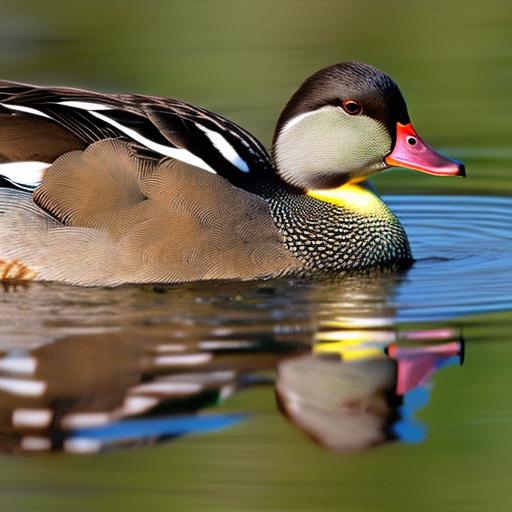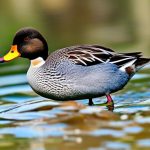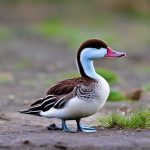Call ducks are a popular breed among duck enthusiasts for their small size and distinctive vocalizations. They are often kept as pets or shown in competitions due to their unique characteristics. Call ducks are known for their round heads, short bills, and compact bodies. They come in a variety of colors and patterns, making them visually appealing to many people. In this article, we will explore the history of call ducks, their physical characteristics, behavior and temperament, popular breeds, care requirements, breeding tips, showing guidelines, and the pros and cons of keeping them as pets.
Key Takeaways
- Call ducks are a small breed of domesticated duck that are known for their distinctive vocalizations.
- The history of call ducks dates back to the 19th century, when they were bred for hunting purposes in Europe.
- Call ducks come in a variety of colors and have a compact, rounded body shape.
- These ducks are generally friendly and social, but can be prone to nervousness and shyness.
- Popular breeds of call ducks include the White, Gray, and Mallard varieties, each with their own unique characteristics.
The History of Call Ducks: From the 19th Century to Today
Call ducks have a long history that dates back to the 19th century. They were originally bred in the Netherlands and were used as decoy ducks to attract wild ducks for hunting purposes. The name “call” comes from their ability to make a distinct call that mimics the sound of a wild duck. This call was used by hunters to lure other ducks into their traps.
Over time, call ducks became popular as pets and show birds due to their small size and charming personalities. They were selectively bred for their unique characteristics, including their small size and vocalizations. Breeders focused on creating a breed that was smaller than other domestic duck breeds and had a distinctive call.
Today, call ducks are enjoyed by duck enthusiasts around the world. They are kept as pets in backyard ponds or gardens and are also shown in competitions where they are judged based on their physical attributes and vocalizations.
Physical Characteristics of Call Ducks: Size, Shape, and Color
Call ducks are known for their small size and compact bodies. They typically weigh between 1-2 pounds and have a round head with a short bill. Their bodies are short and stout, giving them a cute and chubby appearance.
In terms of color, call ducks come in a wide variety of options. The most common colors include white, gray, and mallard. However, there are also other color variations such as buff, blue, chocolate, and silver. Some call ducks have solid colors, while others have patterns such as pied or bibbed.
Behavior and Temperament of Call Ducks: What to Expect
Call ducks are social animals and enjoy being around other ducks. They are known for their friendly and curious nature, making them great companions for duck enthusiasts. They are also highly vocal and communicate with each other through their distinctive calls.
Call ducks are active and energetic birds that enjoy swimming and foraging for food. They are intelligent and can be trained to respond to their names or perform simple tricks. However, they can also be quite mischievous and may get into trouble if not properly supervised.
Popular Breeds of Call Ducks: A Comprehensive Guide
There are several popular breeds of call ducks, each with its own unique characteristics. The White Call Duck is one of the most common breeds and is known for its pure white plumage. The Gray Call Duck is another popular breed, with a grayish-blue coloration that gives it a soft and elegant appearance. The Mallard Call Duck is a breed that closely resembles the wild mallard duck in terms of coloration.
Other popular breeds include the Buff Call Duck, which has a warm buff color, and the Blue Call Duck, which has a bluish-gray plumage. There are also rarer breeds such as the Chocolate Call Duck, which has a rich chocolate brown color, and the Silver Call Duck, which has a silver-gray plumage.
Caring for Call Ducks: Housing, Feeding, and Health Considerations

When it comes to housing call ducks, it is important to provide them with a secure enclosure that protects them from predators. They should have access to water for swimming and foraging, as well as a sheltered area where they can rest and sleep. The enclosure should be spacious enough to allow them to move around freely and engage in natural behaviors.
In terms of feeding, call ducks have similar dietary needs to other domestic duck breeds. They should be provided with a balanced diet that includes a mix of commercial duck feed, fresh vegetables, and access to clean water. It is important to monitor their weight and adjust their diet accordingly to prevent obesity or malnutrition.
Call ducks are generally hardy birds, but they can still be susceptible to certain health issues. Regular veterinary check-ups are recommended to ensure their overall health and well-being. It is also important to provide them with a clean and hygienic environment to prevent the spread of diseases.
Breeding Call Ducks: Tips and Tricks for Successful Hatching
Breeding call ducks can be a rewarding experience for duck enthusiasts. To ensure successful hatching, it is important to select healthy breeding stock. Look for ducks that are in good physical condition, have no signs of illness or deformities, and have a good track record of fertility.
Provide the breeding ducks with a suitable nesting area that is secluded and protected from disturbances. The female duck will lay her eggs in the nest and will incubate them for about 28 days. During this time, it is important to provide her with a quiet and stress-free environment.
Once the eggs hatch, it is important to provide the ducklings with proper care and nutrition. They should be kept in a warm and dry brooder with access to clean water and a balanced diet. Monitor their growth and development closely and seek veterinary assistance if any issues arise.
Showing Call Ducks: What Judges Look for and How to Prepare
Showing call ducks can be a fun and rewarding experience for both the ducks and their owners. When preparing your ducks for a show, it is important to groom them properly. This includes bathing them, trimming their feathers, and ensuring that their plumage is clean and well-maintained.
Judges look for certain criteria when evaluating call ducks in shows. These include the overall size and shape of the duck, the quality and condition of their plumage, and their ability to make the distinctive call. It is important to present your ducks in the best possible condition and to showcase their unique characteristics.
Call Ducks as Pets: Pros and Cons of Keeping Them in Your Home
Keeping call ducks as pets has its pros and cons. On the positive side, call ducks are social animals that enjoy human interaction and can form strong bonds with their owners. They are also highly entertaining to watch and can provide hours of amusement with their playful antics.
However, call ducks require a large enclosure with access to water, which may not be feasible for everyone. They can also be quite noisy, especially during breeding season when the males make their distinctive calls. Additionally, they have specific dietary and care requirements that need to be met to ensure their health and well-being.
Why Call Ducks Make Great Companions for Duck Enthusiasts
In conclusion, call ducks are popular among duck enthusiasts for their small size, distinctive vocalizations, and charming personalities. They have a long history that dates back to the 19th century and have been selectively bred for their unique characteristics. Call ducks come in a variety of colors and patterns, making them visually appealing to many people.
They are social animals that enjoy being around other ducks and can form strong bonds with their owners. Call ducks require proper housing, feeding, and care to ensure their health and well-being. They can be bred successfully with proper planning and care, and can also be shown in competitions where they are judged based on their physical attributes and vocalizations.
While keeping call ducks as pets has its pros and cons, they can make great companions for duck enthusiasts who have the space and resources to meet their specific needs. With proper care and attention, call ducks can provide years of enjoyment and companionship.
If you’re interested in learning more about breeds of call ducks, you might also find this article on converting a shed into a chicken coop from Poultry Wizard helpful. It provides valuable insights and tips on how to create a suitable living space for your feathered friends. Check it out here.
FAQs
What are call ducks?
Call ducks are a breed of domesticated duck that are smaller in size and have a distinctive high-pitched call.
What are the different breeds of call ducks?
There are several breeds of call ducks, including the White Call, Gray Call, Butterscotch Call, Pastel Call, and Black Call.
What is the size of call ducks?
Call ducks are small in size, typically weighing between 1 and 2 pounds and measuring around 12 inches in length.
What is the lifespan of call ducks?
Call ducks have a lifespan of around 5 to 8 years.
What is the temperament of call ducks?
Call ducks are known for their friendly and sociable temperament, making them popular as pets.
What is the purpose of breeding call ducks?
Call ducks are primarily bred for exhibition purposes, but they can also be kept as pets or used for their eggs and meat.
What is the origin of call ducks?
Call ducks are believed to have originated in the Netherlands in the 17th century, where they were used as decoys for hunting wild ducks.
Meet Walter, the feathered-friend fanatic of Florida! Nestled in the sunshine state, Walter struts through life with his feathered companions, clucking his way to happiness. With a coop that’s fancier than a five-star hotel, he’s the Don Juan of the chicken world. When he’s not teaching his hens to do the cha-cha, you’ll find him in a heated debate with his prized rooster, Sir Clucks-a-Lot. Walter’s poultry passion is no yolk; he’s the sunny-side-up guy you never knew you needed in your flock of friends!







